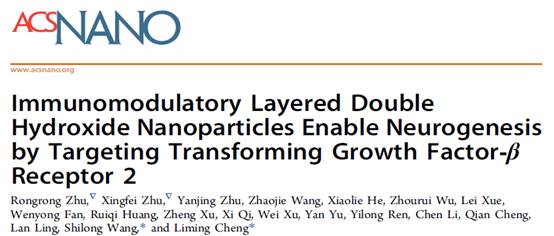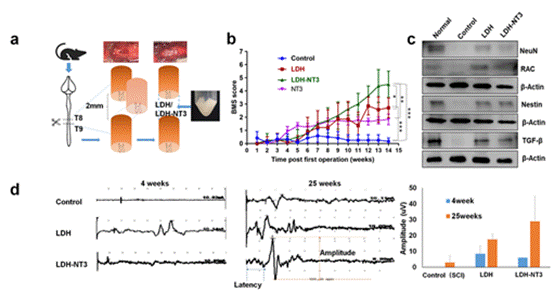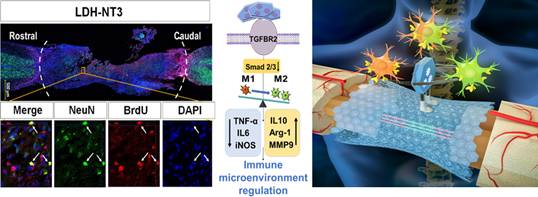Recently, Prof. CHENG Liming’s team at Tongji Hospital, affiliated to Tongji University, published a paper entitled “Immunomodulatory Layered Double Hydroxide Nanoparticles Enable Neurogenesis by Targeting Transforming Growth Factor-β Receptor 2” on-line in ACS Nano, a famous international journal of nanotechnology. The study to which the paper refers shows that layered double hydroxide (LDH) nanoparticles can immune microenvironment amelioration and reconstruction by functional biomaterials, thus becoming a promising strategy for Spinal Cord Injury (SCI) recovery.
SCI is one of the most common major injuries to the central nervous system, often leading to neuronal death and axonal rupture, accompanied by secondary injuries such as cascade inflammatory reaction. It forms an inhibitory pathological microenvironment. The difficulty of treatment lies in improving the injured area’s immune microenvironment to realize nerve regeneration and functional remodeling. In recent years, the use of functional biomaterials to improve and reconstruct the immune microenvironment has become a promising strategy for SCI recovery.

Based on the key laboratory work on “Spinal Cord Injury Regeneration and Recovery” supported by the Ministry of Education, Prof. CHENG Liming’s team has developed a biodegradable LDH nanoparticle with the support of the national key research and development program on the “Mechanism and Translation of Spinal Cord Injury Recovery Based on Mobilized Endogenous Neural Stem Cells”. This biodegradable LDH nanoparticle can modulate immune cell typing and suppress the inflammatory response in the injured area, achieving significant performance in accelerating neural stem cells (NSCs) migration, neural differentiation, L-Ca2+ channel activation, and inducible action potential generation. LDH loaded with neurotrophic factor (NT3) formed a nanocomposite system (LDH-NT3), which was transplanted into a mouse’s SCI area. New BrdU+ endogenous NSCs and functional neurons were seen in the injury area, which significantly improved the behavioral and electrophysiological evaluation of the mouse with SCI. Since LDH material has the effect of promoting nerve regeneration, the effect of LDH-NT3 on SCI recovery showed more improvement than that of LDH.

Figure 1. The motor function of the mouse with SCI recovering effectively with LDH and LDH-NT3 nanoparticles
This study uses pathway analysis to screen 57 genes to form a protein-protein interaction (PPI) network map associated with the functions of neural precursor cell proliferation and immune dysfunction, among which transforming growth factor-β receptor 2 (TGFBR2) is positively associated with the biological processes of neural regeneration and immune regulation. It is a key gene for LDH to promote SCI recovery. Immunofluorescence staining for nestin and TGFBR2 was performed at the lesion site, and the results showed that the expression was increased in both LDH and neonatal neural regions of the LDH-NT3 transplantation group. LDH can induce M2 phenotypic polarization of microglia and macrophages through activation of TGFBR2, effectively improving the immune microenvironment.

Figure 2. The immune microenvironment of the injured area and the regeneration of nerve cells improved with LDH-NT3 nanoparticle
This study finds that LDH can be used to construct a suitable immune microenvironment for SCI recovery and can load various neurotrophic factors, revealing the membrane receptor targets of material to improve the microenvironment and the fundamental molecular mechanism of pro-neural regeneration, providing a new strategy for biological material immune regulation for SCI recovery.
